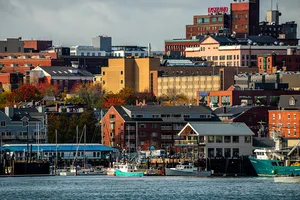
Maine was admitted to the Union on March 15, 1820, becoming the 23rd state. Maine is known as the “Pine Tree State” and "Vacationland". It is the "Pine Tree State" because more than 80% of Maine’s landscape is forested. Maine is also known as Vacationland or the Vacation State because it receives about 25 million visitors a year. Maine is the 12th smallest state by area in the United States.[1]
As of 2020, the total population of Maine is approximately 1,362,359.[2] Maine’s economy has passed through stages typical of most states, with an initial focus on extractive activities (fishing, logging, slate and granite quarrying, other mining, and ice harvesting), and moving from subsistence farming to substantial agricultural development.[3]
For all of 2021, Maine’s economy grew 5.2%.[4] The three sectors that contributed the most to Maine’s 4th quarter growth were real estate, accommodation and food service, and agriculture.[5] Beyond its economic importance, Maine's natural beauty is its biggest draw. Rugged mountains, pristine lakes and rivers (over 6,000!), and a dramatic coastline with thousands of islands make it a haven for outdoor enthusiasts.[6]
Acadia National Park is one of the 10 most visited national parks in the United States, drawing 4 million visitors annually to Maine with its secluded beaches, rugged mountains, dense forests, and craggy coastal views along the Atlantic Ocean. The Old Port and Portland Head Lighthouseis located in Portland, these are must-visit spots for their charming cobblestone streets, shops, restaurants, and the iconic lighthouse. There are many other attractions in Maine including Marginal Way and Ogunquit Beaches, Coastal Maine Botanical Gardens, Baxter State Park, and Destination Moosehead Lake.
Research your ancestors on MyHeritage
History of MaineHistory of Maine
The first known European contact with what is now Maine was made by a Portuguese explorer, Estevan Gomez, in 1525.[7] However, the first significant English settlement occurred in 1607 with the establishment of Popham Plantation at the mouth of the Kennebec River.[8] The first European settlement in the area was made on St. Croix Island in 1604 by a French party that included Samuel de Champlain and Mathieu da Costa.[7][9]
Admission to the Union Maine was initially part of the Massachusetts Bay Colony, which was established by the English in 1620. As part of the Missouri Compromise between the North and the South, Maine was admitted into the Union as the 23rd state on March 15, 1820.[10]
During the American Civil War, Maine played a significant role.[11] As a fervently abolitionist and strongly Republican state, Maine contributed a higher proportion of its citizens to the Union armies than any other, as well as supplying money, equipment, and stores.[12]
The period of greatest economic growth in Maine came between 1830 and 1860, when the production of lumber, ice, granite, and lime (extracted from limestone), along with fishing and shipbuilding, dominated the state’s economy. In the 19th century, the promise of jobs in the timber industry lured many French Canadians to Maine from the Canadian province of Quebec.[13]
In the 20th century, Maine’s economy and employment profile changed significantly. Most notable was the decline of the longtime dominant manufactures of textiles, shoes, processed food, paper, wood products, and electronic components. Balancing these developments was a dramatic expansion of tourism.[14] The state’s cultural landscape also underwent changes, signifying a greater consideration for minority populations.[14]
Demographics of MaineDemographics of Maine
The demographic distribution of Maine population is as follows:[15]
- White: 92.93%
- Two or more races: 3.46%
- Black or African American: 1.44%
- Asian: 1.1%
- Native American: 0.56%
- Other race: 0.5%
- Native Hawaiian or Pacific Islander: 0.02%
Most common surnames in MaineMost common surnames in Maine
Researching family history in MaineResearching family history in Maine
The National Archives at Boston has records from federal agencies and many other federal records for Connecticut, Maine, Massachusetts, New Hampshire, Rhode Island, and Vermont. The Maine State Archives has original record collections from state agencies and divisions. The Maine Historical Society Brown Library Preserves the heritage and history of Maine through extensive historical records many of which are genealogically valuable. The Maine State Library has diverse records and also supports the Digital Maine Library. Maine also has a number of local public and county libraries with document collections.
Maine County ListMaine County List
Maine has 16 counties:
| Androscoggin | Aroostook | Cumberland | Franklin |
| Hancock | Kennebec | Knox | Lincoln |
| Oxford | Penobscot | Piscataquis | Sagadohoc |
| Somerset | Waldo | Washington | York |
See alsoSee also
Explore more about MaineExplore more about Maine
MyHeritage.com has 51 collections of valuable genealogical records for Maine. The records include Maine Newsapers, 1861-2008, Maine Marriages, 1892-1966, Maine, Marriages, US Naturalization Records, New England, 1791-1906, and Maine Deaths. There are also valuable records in the Maine Collections Catalog.
References
- ↑ 53 Interesting Facts About Maine | What Is Maine Known For?
- ↑ Maine | Data USA
- ↑ Economy | Maine: An Encyclopedia
- ↑ Maine's economy finished 2021 with strong economic growth
- ↑ Maine's economy finished 2021 with strong economic growth
- ↑ The Pros and Cons of Living in Maine: A Closer Look at the Pine Tree State’s Allure and Challenges
- ↑ 7.0 7.1 Timeline Maine History: Exploration, Early European Settlement | Maine: An Encyclopedia
- ↑ Exploration and Settlement of Maine
- ↑ Mathieu Da Costa
- ↑ How Maine Became a State
- ↑ Civil War | Maine: An Encyclopedia
- ↑ Maine and the Civil War
- ↑ Remembering how Mainers lived 200 years ago
- ↑ 14.0 14.1 Maine - History, Geography, Economy | Britannica
- ↑ Maine Population 2024 (Demographics, Maps, Graphs)
- ↑ Most Common Surnames in Maine, With Meanings

